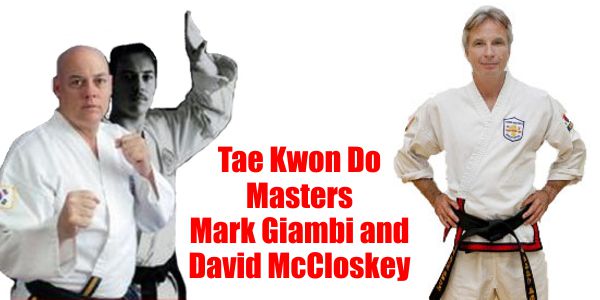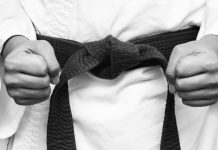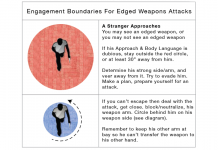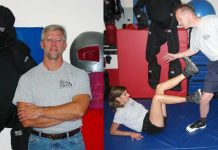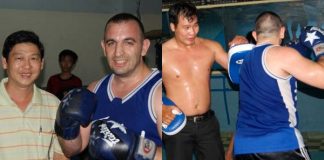The most important space for any fighter is the distance that separates them from their opponent. Closing that gap is the key to executing a successful attack or counter attack. In a tournament the science of closing the gap may result in trophies and medals, but in the street it could be the difference between life and death.
Tae Kwon Do masters Mark Giambi (6th Degree Black Belt) and David McCloskey, (5th Degree Black Belt) from Houston Texas are two of the most successful instructors of the ancient Korean art in the Lone Star state.
“Learning how to close the gap on your adversary is one of the most important things a martial artist needs to learn,” says Giambi. “It takes precise timing combined with the ability to read your opponent’s intentions. In that instant you must be able to determine your attack or defense. And that initial move will often times be the deciding factor in a fight.”
“We spend a great deal of time teaching our students how to close the gap,” added McCloskey. “For sparing purposes 80 to 90% of our time is spent on learning how to close the gap and on setting up the opponent for a first strike or counter attack.”
To illustrate these techniques the three of us went to a nearby park where Master Giambi and McCloskey demonstrated their favorite methods for closing the gap, Tae Kwon Do style.
“When my opponent moves forward, preparing to attack me with a rear foot roundhouse or a turning kick I like to close the gap with a reverse lunging punch,” said Giambi.
“When the attacker has most of his weight on the front leg you know the attack is coming from the rear leg,” McCloskey added. “So when you see that distribution of weight drop, you move in quickly, closing the gap and scoring before they can get off.”
“When you throw the reverse lunging punch it’s important to move your hand first, not your feet or lower body,” explained Giambi. “Get the hand moving forward and let the body follow behind it. Then after you have punched your opponent move off to the rear. That cuts off any chance he has of executing a counter attack, usually a back kick..
Master Giambi demonstrated the technique on his friend, leaving no doubt as to the effect and power of the Tae Kwon Do lunging punch.
“Oh man, you barely hit me and I’m still feeling the shock wave,” said McCloskey as he was recovering his balance. “There was some real effective penetration there.”
“The reason why that punch is so powerful is because of its straight line of attack,” explained Giambi. “As you lunge forward all of your weight is behind the attack, your hips and hand are turning, you’ve got all the factors working together, making for one very powerful punch.”
“I can tell you from an impact perspective that this isn’t just a surface blow, it actually sends shock waves internally that leaves you feeling sick inside,” McCloskey attested. “Sometimes you’ll get hit with a punch and it’s no big deal, but this lunging punch will leave your entire body in shock.”
“Again I’m going to ‘jam’ my opponents attack by closing the distance with my body by moving forward then I’ll attack by striking over the top of his hands,” Giambi explained. “After jamming his legs I’ll throw a hooking punch, which is also a very powerful strike, and again I can escape to the side or add an upper cut to his kidney.
Most of the time when you’re closing the gap like that you’ve got to be aware of your opponents front leg, Giambi added. It takes a little longer for them to execute an attack off their rear leg so it’s easier to read. The front leg however is closer and faster. So I want to close the gap, punch him, but avoid getting kicked by his front leg in the process. If I lean in and punch I can pretty much get him, but if I stay out too far he can roll his hip and turn it into a side kick on me. So I’ll move in with my knee high to block or jam his front leg, then I’ll come over the top with my opposite hand. And again as in the lunging punch all of your weight is moving forward making for a very powerful attack.”
“It’s quite common in Tae Kwon Do for two fighters to get their front legs tied up,” said McCloskey. “When that happens we like to take advantage of our opponent by driving him backwards with a punch, however many Tae Kwon Do fighters will negate the punch to set up for another kick.”
“A lot of times they’ll drop their foot and instead of throwing a hand technique, Giambi added. “They’ll set their foot down then kick again. What they should do is throw a lead punch the instant their legs get tied up.”
“It’s important to remember to punch at the same time as your going in,” said McCloskey. “You don’t want to move in then punch. That will throw your timing off and the punch will not have the desired effect.”
I found it interesting that these two Tae Kwon Do champions elected to use so many hand techniques as finishing moves after closing the gap on their opponents. Its well known that while the Korean martial art is famous for its kicks, however punching techniques are seldom stressed, let alone used in such an effective manner.
“A lot of people have the misconception that Tae Kwon Do stylists can’t punch,” said Giambi. “They can, but many choose not to because they’re tournament fighters and they elect to follow certain rules that govern competition. As you know, it’s very difficult to get a point in a Tae Kwon Do match with a punch.”
Both Giambi and McCloskey are members of the Young Brothers Tae Kwon Do Association and they credit their exceptional hands to their teachers Grand Master IL Young and Master Young Bo Kong.
“We both give all the credit to our teachers when it comes to our exceptional punching techniques,” said Giambi. “They were the first to incorporate a variety of western boxing techniques into traditional Tae Kwon Do. You’ll never see another Tae Kwon Do person punch like Master Kong. Front hand, back fits, hooks, uppercuts, he does it all.”
Like all good fighters these two Young Brothers disciples know the importance of closing the gap and setting up an attack using both hands and feet. The old adage, “use the hands to set the feet, and the feet to set the hands” is a reliable and adhered to guide for both Giambi and McCloskey. However, these exceptional kickers also know how to cut the gap quickly with one of their most effective weapons, the sidekick.
“When I do a side kick I like to close the distance by sliding up with my back leg and simultaneously throwing a side kick with my front leg,” said Giambi. “There’s no giveaway to what you’re doing. Some people like to do three-step moves then throw the kick. That takes too long to set up and it gives your opponent a lot of time to react or read your move. In addition to being a very effective way to close the gap, the slide up or slide back sidekick is also a very powerful defensive move. If someone rushes you, just slide back, creating a little space to avoid the attack then counter with a kick of your own.”
“Because you’re using your opponents energy you don’t have to extend the leg or kick extremely hard to be effective,” McCloskey added. “Most people get in trouble using a side kick when it’s fully extended because that puts you off balance when you try to stretch it out to reach the target. But if you use it to attack and slide properly you can maintain your balance and still continue forward.”
The two Tae Kwon Do experts went on to explain that it is important to keep your knee up, cocked high and drive it in on a straight line for maximum stopping power and to kick at the same time as you slide. And according to Master Giambi it doesn’t matter what part of the foot you kick with as long as some part finds the target.
“This is another blow that is very penetrating,” Giambi said. “It doesn’t matter if you use the heel or the blade of your foot, if you slide up properly, cock your leg and drive in on a straight line without over extending, the kick will really put the hurt on someone. Another thing to remember is to stay relaxed. If you tighten up your foot that will in turn tighten up your calf and that will slow down your kick. The hardest part about doing this kick is to learn how to tighten up on impact, just like you do with your fist. I keep my foot lose and let it hit, then I tighten up. That’s where the power comes from.”
The Tae Kwon Do master instructor went on to say that being picture perfect isn’t always the most effective position to have when a person is throwing the kick for maximum power.
“In a lot of photos you see that perfect Tae Kwon Do kick but in sparing it’s not that perfect-looking kick that will score,” Giambi said. “Being able to kick off at an odd angle or to slightly change the kick or position of the knee may be enough to confuse your opponent allowing you to score. That’s another way to close the gap between you and your opponent.”
“A lot of times when I’m sparing with Master Giambi his knee comes up but I don’t see his foot because he angles off to the side and the next thing I’m getting hit before I can see the foot,” said McCloskey. “By doing that he has mentally closed the gap on me and before I can figure out where the attack is coming from he’s already scored on me.”
Both Masters Giambi and McCloskey realize that one of the most effective ways to set up your opponent is to maneuver off line, thus putting the attacker in an awkward offensive position while opening him or her up for an attack.
“We have some great ways to close the gap with off line techniques,” Giambi said. “Our down kick and ax kick can both come from an off line attack. To set someone up for this attack I like standing him or her up with something else then throwing either kick. I wouldn’t start off with a sweeping technique like the ax or down kick because it takes them too long to develop. If you get your opponent to back up, maybe with a lung punch or front kick then you have a better chance of landing the ax or down kick.”
“Although both of those kicks are very powerful they can be countered or avoided if you try to throw them from a sparing position, McCloskey added. “Often times your opponent can close the gap on you before you will be able to land the kick, so it’s important to close the gap by attacking them first.”
“To close the gap for either of these two kicks I want to get my opponent backing up and put him in a defensive posture before I execute the kick,” Giambi said as he demonstrated the move on his McCloskey.
Another favorite move of both Master Giambi and McCloskey is their diagonal or half-round kick.
“First I move off at a 45 degree angle that usually will result in your opponent moving into your attack, ” says Giambi. “In essence, you’ve made your opponent close the gap for you. Now you set up for the attack. It’s important that the knee and foot move first ahead of the body then you thrust your kick into the target.”
Another way Giambi and McCloskey will close the gap on their opponent is by blocking and redirecting their attacker.
” As a kick comes in I’ll redirect foot with my hand and move it off to the side,” Giambi said while demonstrating the move on McCloskey. “Once the attacker if off balanced I like to attack with a punch.”
Master Giambi was at one time one of the nations leading fighters in addition to winning numerous 1st place trophies on the East coast he was the Texas middleweight champion 5 years in a row and 4-time Houston Grand Champion. Giambi has been teaching Tae Kwon Do in Houston since 1982 making his dojang the oldest and most successful one of its kind in the state.
With all those years of experience in the ring and as a master instructor Giambi knows the value of being able to spot and analyze your opponents body language. Knowing how to read your opponent’s moves will often give a person the split second edge that separates victor from loser.
“What I notice is that a lot of fighters will do a move before their final move,” Giambi noted. “They’re not just kicking off the front leg. First they will slide up on the back leg before lifting their front leg. This is a real waste of time and motion and telegraphs their intent. The instant I see them do that I slide up sidekick. I move once, they move two times. So who’s going to land the kick first? Do the math.”
Although the techniques Masters Giambi and McCloskey demonstrated are effective in both the classroom and the street, they are quick to point out that while the applications may be the same, there is a big difference in the execution when a person’s life is on the line.
“When you close the gap in the street, during a real fight I believe you need to throw your techniques a lot lower,” Giambi said. “I wouldn’t throw anything above the waist when my life is on the line. Kicks to the head may score points in a tournament, but in the street you stand a good chance of getting dumped. Regardless of how good your are, a kick to the head puts you at risk in the street. So I’ll use the same moves that I use in class to close the gap on the bad guy, but when I attack I’ll go to the knees, groin, solar plexus, kidney or spine. The whole point of a real fight is to get it over with quickly and to walk away unharmed.”


